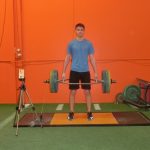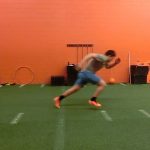Understanding How to Jump Higher
At F2P we have developed a strong reputation in the volleyball and basketball communities of increasing the athlete’s vertical jump. As is always the case, our programs are designed to increase the athlete’s overall athletic ability for their sport, in volleyball and basketball jumping higher is part of that. So how do we go about doing this? The first place we start is teaching athletes how to jump. Every athlete that comes in wanting to jump higher gets asked the same question, “Do you know how to jump?” Most of the time the answer is, “Of course I do.” However, ask them to explain it and the most the common answer is, “You go down and up.” In reality, jumping is a lot more complicated than that.
When developing an athlete’s jumping ability, I always start with teaching them the phases of the jump. From here it is prescribing the correct exercises to enhance their weakest phase of their jump. I break the jump phases into the loading phase, the reactive phase, and the takeoff phase. When teaching someone to jump higher one phase is no more important than another if the athlete doesn’t know what goes into each phase. So I generally will take the athlete through a general training protocol teaching all three phases before only working on one specific.
Although, it is the last phase of the jump I start by teaching the takeoff phase. In order to take off better, the athlete has to place themselves in an optimal position in order to put a lot of power into the ground. If you aren’t in the correct position for the correct muscles to fire you aren’t going to be able to use them. Once the athlete is in the correct position, they have to have the correct joint firing pattern. These days most people talk about the importance of the hips creating the power. And that is very much the case as if they don’t initiate the movement of the push off they won’t be used maximally. However, not placing importance on the knee and ankle extension as well will limit the speed at which the force will be created. And in order to enhance the takeoff phase of jumping, you need to create a high amount of force in a shorter amount of time.
The better an athlete can load, or get into, optimal jumping position the greater potential they will have to jump higher. Think of the loading phase as building up energy in your muscles and tendons. Your muscles and tendons are essentially rubber band like, meaning they are elastic, or want to stretch and snap back, in nature. Just like a rubber band the quicker you can load, or stretch, into position the more snap you will have coming out of that position. Thus, the quicker the athlete can get their hips, knees, and ankles in an optimal relationship to store the greatest amount of energy they personally can, the greater potential they will have to jump higher. It is also important to take into consideration the way an athlete has to or gets into the jump position for their sport. It might be a dip, step, jump, or even running into position. It might be on 1 or 2 legs. Thus, when you teach the loading phase you need to consider the manner in which you load in order to get maximum carry over in their sport during competition.
The reactive phase will bridge the gap between the other two phases. It is being able to go from the loading phase, or stretching of the muscle, into the takeoff phase, or shortening of the muscle, as quick as possible. The quicker an athlete can transition from the loading phase to the takeoff phase the more of the potential energy from the stretch they will be able to use. Depending on the loading action (a dip, step, jump or run) the stretching force could be several times the athlete’s body weight. So making sure the athlete has the strength to stabilize this force (yielding strength) is extremely important. Even if the athlete has the strength to stabilize this force they still have to have the strength to overcome the force (reactive strength) in order to reach their full jump potential.
The makings of what goes into a jump is very complicated. However, the better you understand what goes into, or how to, jump the better you will become. You need to look at jumping ability as a skill. And in order to enhance skill, optimal practice needs to take place. Looking at, teaching, and enhancing the three phases of the jump (the takeoff, the loading, and the reactive) will enhance your jumping ability. The importance needs to be placed on performing the three phases of the jump correctly, not as many times as possible, because the way you train to jump is going to be the way you jump in competition.





